How to Gain Muscle & Lose Fat: A 4-Step Process (With Meal Plan)
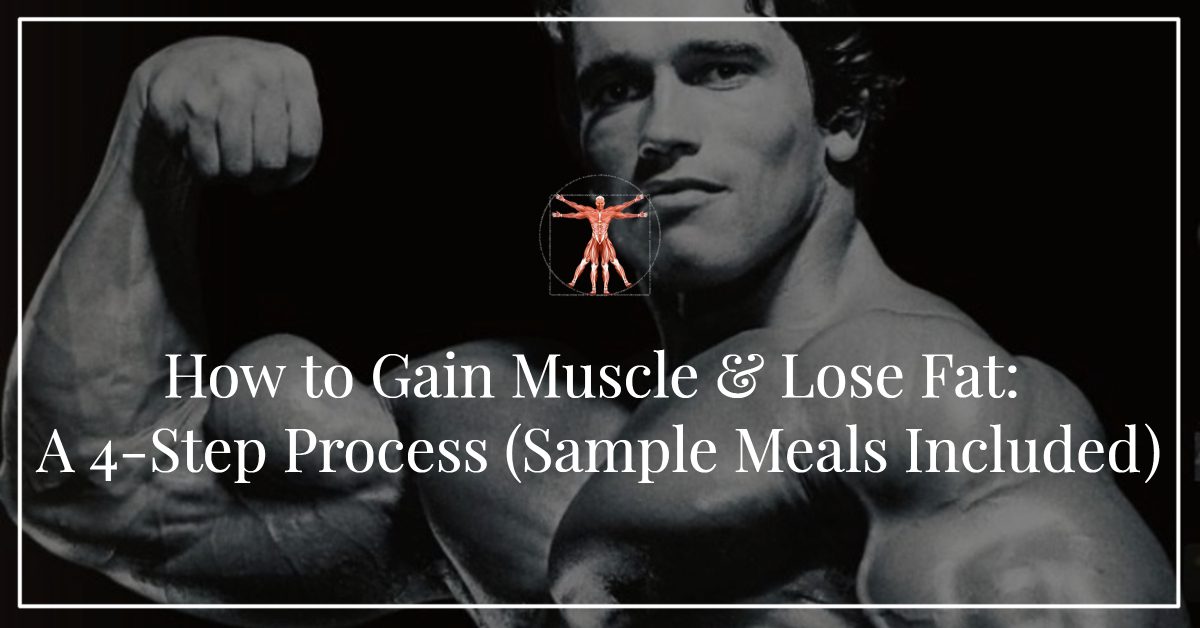
Have you heard it’s impossible to lose fat while gaining muscle?
An impressive number of studies demonstrate this to be false (see Benito et al. 2020 for a review and meta-analysis of 111 studies).
I’ve seen it firsthand. In my own study, 20 women gained 3.31 lbs of lean mass while losing 1.5% body fat in 8 weeks (Cholewa et al. 2018).
Others also found people new to training can increase lean mass and decrease fat mass by as much as 3-5% during the first 3 months (Rossi et al. 2018; Franco et al. 2019). Even people with more training experience, like NCAA athletes, can improve lean and fat mass simultaneously (Rossi et al. 2017).
In this guide, you’ll find the exact 4-step process I use with my clients who want to gain muscle and lose fat. You’ll also find an example meal plan with calories and macros to help you do that.
How to gain muscle & lose fat
Experience and initial body composition matters
Those most likely to see large changes in body composition fall into one or more of the following categories: new to resistance training, overweight, under-muscled, and young.
Body composition changes will be much slower in those who are already lean or have considerable muscular development. These individuals would be better suited to a periodized nutrition and training approach.
What does it take to lose fat while gaining muscle?
Issacs Newton’s first law of thermodynamics, the law of conservation of energy, states that in a closed system, energy can neither be created nor destroyed.
What does this have to do with getting ripped or toned?
Energy Balance
When energy intake exceeds energy expenditure, excess energy will be stored as tissue, causing an increase in body weight (Figure 1a).
Figure 1a—Law of conservation of energy with a surplus resulting in tissue mass increase
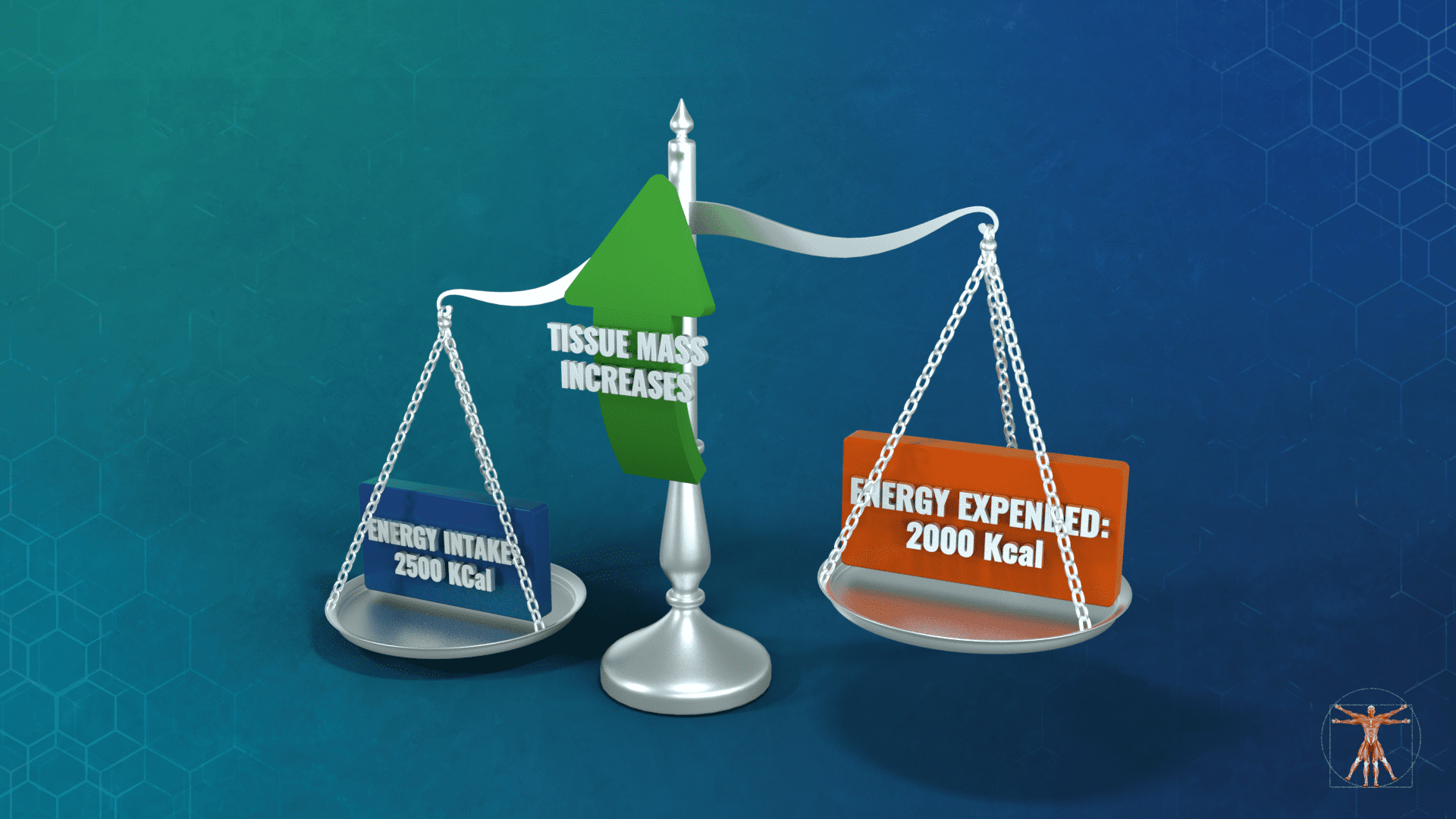
When energy expenditure exceeds intake, tissues will be catabolized to provide energy and body weight will decrease (Figure 1b).
Figure 1b—Law of conservation of energy with a deficit resulting in tissue mass decrease
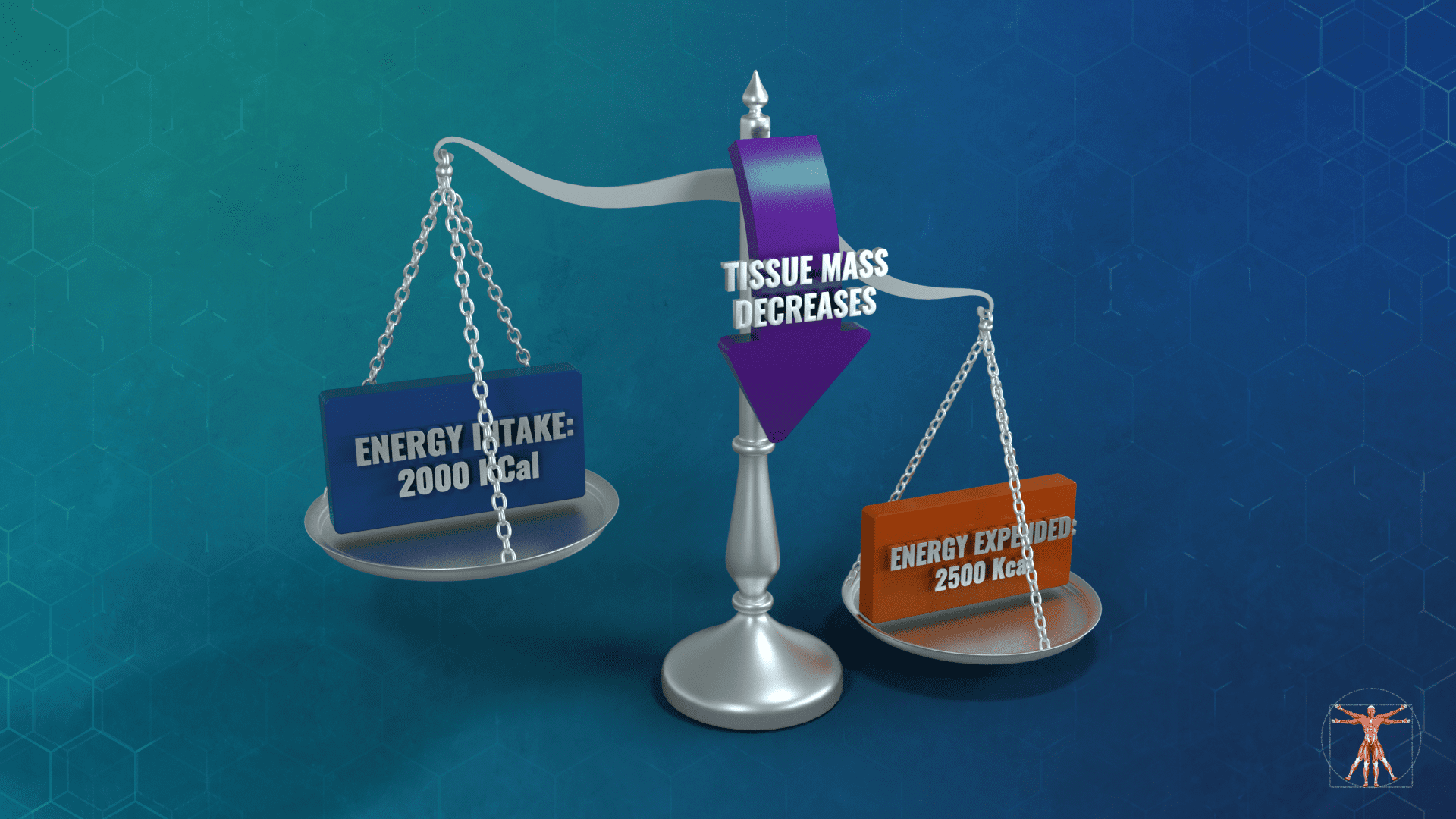
Reducing body fat mass requires us to eat less than we burn. But increasing lean mass requires us to eat more than we burn. How can we do both at once? And, how do we ensure the weight lost is fat mass, or gained is lean mass?
Step 1: Appropriate Energy Intake
In the early stages of resistance training, the cellular mechanisms responsible for muscle hypertrophy are hypersensitive to anabolic stimuli and not as easily inhibited by negative stimuli (Figure 2).
Figure 2—Promotors and inhibitors of muscle growth
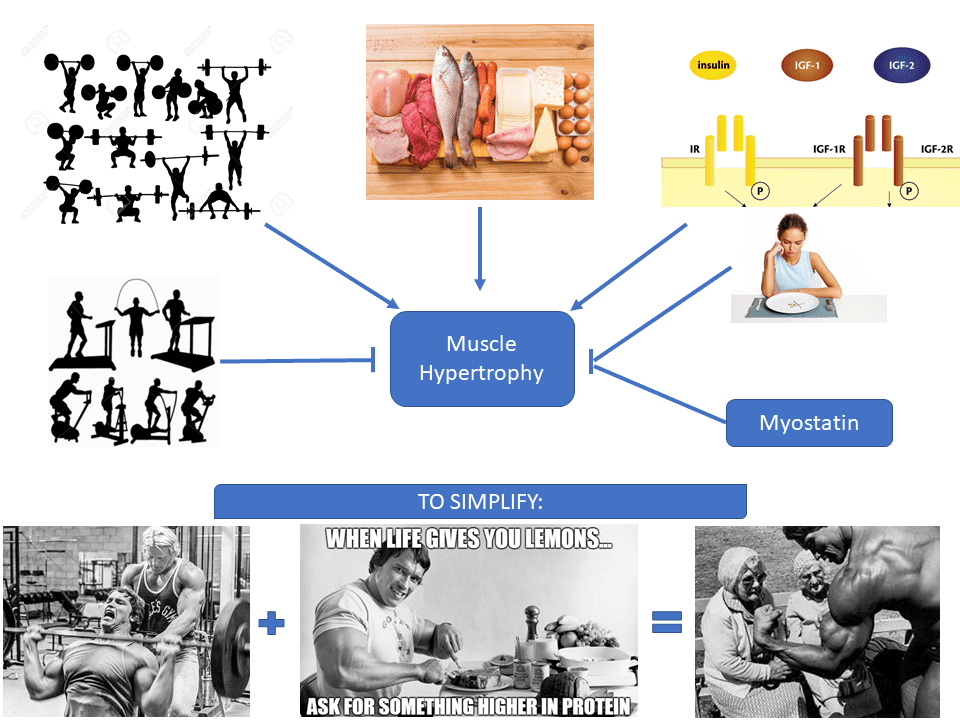
This means that doing some cardio and/or eating less calories than one expends will not have the same negative effects on muscle hypertrophy as someone who is experienced, muscular, and/or lean.
Synthesizing muscle is an energy expensive process. It requires approximately 2000-2500 kcal of energy to build one pound of muscle. As much as a half-pound of lean mass can be synthesized per week in individuals new to training. This equates to a weekly energy expense of about 1000 kcal.
One pound of body fat provides approximately 3500 kcal of energy. Some of the additional energy necessary to fuel muscle growth can be derived from breaking down fat stores. Reducing weekly energy by 1500 kcal (~200 kcal/day) in addition to the energy costs muscle growth can lead to reductions in body fat by about ½ pound per week.
Determining and Adjusting Energy Requirements
Daily energy expenditure is comprised of four components (see Figure 3).
Figure 3—Components of daily energy expenditure
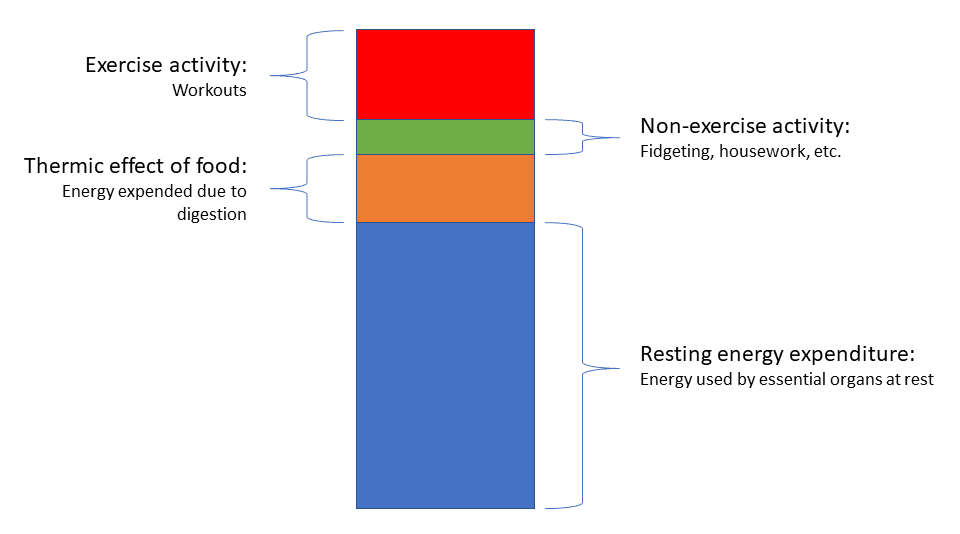
Although measuring metabolic rate requires access to lab equipment, you can estimate your daily energy expenditure using the Harris Benedict formulas.
First, calculate your resting metabolic rate, using your weight in pounds and height in inches.
Women = 655+(4.35 × weight)+(4.7 × height)-(4.7 × age)
Men = 66+(6.23 × weight)+(12.7 × height)-(6.8 × age)
Next, apply the energy costs of activity. Multiply your resting metabolic rate by whichever factor best describes your level of activity in the table below.
Table 1—Harris Benedict Activity Multiplier
| Classification | Description | Multiplier |
|---|---|---|
| Sedentary | Little or not exercise | RMR x 1.2 |
| Slightly active | Light exercise/sports 1-3 days per week | RMR x 1.375 |
| Moderately active | Moderate exercise/sports 3-5 days per week | RMR x 1.55 |
| Very active | Hard exercise/sports 6-7 days per week | RMR x 1.725 |
| Extra active | Very hard exercise/sports, multiple daily sessions | RMR x 1.9 |
Finally, subtract 200 to 300 kcal per day from your estimated total daily energy expenditure to create a deficit small enough to promote fat loss, but not so great it impedes muscle growth.
Step 2: Prioritize Protein
Study after study shows that higher protein diets result in greater improvements in body composition than moderate or lower protein diets. These outcomes have been found in young and old, untrained and trained, and in men and women.
While the interpretation of “higher protein” varies, the majority of studies have employed 1.8 to 2.4 grams of protein per kg of body mass per day. For most individuals, about 1 gram of protein per pound of body mass per day is ideal.
Step 2A: Should I reduce fats of carbs?
A higher protein intake will generally provide about 35% of daily calorie intake, leaving 65% of total calories to be consumed by carbohydrate and fat.
A recent study compared weight loss outcomes during a low-carb or low-fat diet. The study also assessed whether genetics played a role in the weight loss response to low-fat or low-carb. After 12 months of dieting, there were no differences between the diets and genetics did not influence the outcomes.
For fat loss, it probably doesn’t matter much whether you reduce carbohydrate or fat, as long as protein remains high. For muscle hypertrophy there is a small advantage to maintaining carbohydrate intake and reducing fat.
As a general recommendation, take your non-protein calories and split them 60/40 (carbohydrate to fat).
Step 3: Prioritize Resistance Training
Increasing lean mass increases total daily energy expenditure. You’ll burn slightly more calories at rest and during exercise.
Muscle tissue is also the primary lean site for glucose disposal. In very simple terms, by increasing muscle you’ll store more carbohydrates as glycogen while converting less to fat.
For these reasons, resistance training should be the foundation of any exercise program designed to improve body composition. Resistance training should be performed first in the workout, when motivation and focus are high and fatigue is low. If you’re new to resistance training, see our Definitive Guide to Muscle Hypertrophy for Beginners. More advanced? Our smart workout app can automate the complexities for you.
What about cardio?
Cardio training should be performed following resistance training, or on non-resistance training days. Visualize cardio as a tool to increase total daily energy expenditure and maintain cardiorespiratory health, and not as the primary driver of fat loss.
Step 4: Monitoring Progress
The Harris Benedict equation provides an estimation of daily energy expenditure, and will overestimate for some and underestimate for others. You’ll need to routinely measure your progress and modify your diet to achieve your goals.
Body Fat Percentage
Body composition assessments give a fairly accurate measurement of lean mass, fat mass, and body fat percentage. These are often available at local universities with an exercise science program for a nominal fee (~20-40$ per test), and should be performed once every 4-8 weeks.
To make sure the results you compare are accurate, you’ll need to duplicate the conditions from test to test. This includes clothing, food and beverage intake the day before and morning of, and any exercise done the day before. It’s also important to use the same testing tool each time. Different methods have varying levels and directions of error (i.e.: DEXA often overestimates while BIA often underestimates).
Weight and Girth Measurements
Body weight in conjunction with girth measurements of the thighs, waist, and arms are also effective, low cost options to monitor progress. When taking body weight, it’s important to measure under the same conditions (i.e.: first thing in the morning after using the bathroom) and frequently to avoid misinterpreting fluctuations in weight (see video below).
Bonus 1: 2 more advanced considerations when trying to build muscle & lose fat
While consuming an appropriate energy intake and macronutrient distribution will have the biggest impact on body composition, there are other strategies that can improve consistency and outcomes. Once you master the basics, consider the following two more advanced considerations:
1—Nutrient timing
The average American consumes approximately 11% of their protein at breakfast, 16% at lunch, and the remainder at dinner. Distributing protein fairly evenly between three to five meals, with one protein rich meal in close proximity to training (i.e.: 1-2 hours post training) is a simple way to maximize protein synthesis throughout the day.
2—Food quality
Eating a variety of nutrient dense foods reduces the risk of vitamin/mineral deficiencies, ensures adequate fiber intake, promotes satiety, and slightly increases the thermic effect of food. Fruits, vegetables, whole grains, tubers, lean meats, nuts/seeds, and low-fat dairy are all examples of nutrient dense foods. Snack foods (i.e.: crackers, chips), sweets, and processed meats are some examples of low nutrient density foods.
Bonus 2: Example calorie and macronutrient calculations
Our case study is a 26-year-old male, 5’10, 185 lbs, and 18% body fat (lean is considered to be < 10% body fat). He is planning a three day a week resistance training program with two additional days of cardio in the form of recreation league soccer.
Step 1: Energy Requirements
RMR = 66+(6.23 × 185)+(12.7 × 70)-(6.8 × 21) = 1930 kcal
Activity is moderate: Daily energy expenditure = 1930 x 1.55 = 2992
To create a deficit for fat loss, we subtract 300 kcal.
Daily energy intake will be 2692 kcal.
Step 2: Macronutrients
Prioritize protein: 185 lbs x 1 g = 185 g
Protein provides 4 kcal/gram: 185 x 4 = 740
Remaining kcals: 2692 – 740 = 1950
Split 60/40 (Carb:Fat):
1950 x .6 = 1170 kcal from carbohydrate
1950 x .4 = 780 kcal from fat
Carbohydrate provides 4 kcal/gram: 1170 ÷ 4 = 292 g carbohydrate
Fat provides 9 kcal/gram: 780 ÷ 9 = 87 g fat
Daily macronutrients: 185 g protein; 292 g carbohydrate; 87 g ft
Bonus 3: Example Meal Plan
Table 2—Example Meal Plan
| Breakfast | KCAL | CARB. | FAT | PROTEIN |
|---|---|---|---|---|
| Spinach – Raw, 1 cup | 7 | 1 | 0 | 1 |
| Bread, wheat, toasted, 2 slice | 150 | 27 | 2 | 6 |
| Orange – Orange, Large, 1 large orange | 87 | 22 | 0 | 2 |
| Egg – Egg, 4 large | 286 | 1 | 19 | 25 |
| Egg Whites – Original, 6 Tbsp (46g) | 50 | 0 | 0 | 12 |
| Breakfast Total | 580 | 51 | 21 | 46 |
| Lunch | ||||
| Carrot – Carrot (Large), 1 unit | 30 | 7 | 0 | 1 |
| Filippo Berio – Olive Oil, 1 Tbsp | 120 | 0 | 14 | 0 |
| Broccoli, raw, 1 cup chopped | 31 | 6 | 0 | 3 |
| Homemade – Sweat Potato Baked, 200 g | 180 | 41 | 0 | 4 |
| Banana, 1 medium | 105 | 27 | 0 | 1 |
| Tilapia – Tilapia, 8 oz | 200 | 0 | 5 | 40 |
| Lunch Total | 666 | 81 | 19 | 49 |
| Dinner | ||||
| Parkhurst – Brussel Sprouts, 4 Oz | 48 | 9 | 0 | 4 |
| Vegetables – Mixed Vegetables, 0.67 cup | 60 | 11 | 1 | 2 |
| Lindberg – Basmati Brown Rice, 0.75 c | 450 | 99 | 5 | 12 |
| S – Steak, New York Strip Steak, 6 oz. Cooked (85g) | 233 | 0 | 8 | 38 |
| Dinner Total | 791 | 119 | 14 | 56 |
| Snacks | ||||
| Banana’s – Banana, 1 medium (17-20 cm) | 105 | 27 | 0 | 1 |
| Almond Milk – Almond Milk – Vanilla – Unsweetened, 6 oz | 30 | 1 | 3 | 1 |
| Optimum – 100% Whey Protein, 30 g | 120 | 3 | 1 | 24 |
| Peanut Butter, 4 tbsp | 380 | 16 | 32 | 14 |
| Snack Total | 635 | 47 | 36 | 40 |
| Totals | 2672 | 298 | 90 | 191 |
Yes, you can gain muscle & lose fat
As we’ve seen, beginners (and even NCAA athletes) can gain muscle and lose fat at the same time. You can do it by following the 4-step process we outlined above:
- Get an appropriate energy intake
- Prioritize protein
- Prioritize resistance training
- Monitoring progress (and adjust)
That’s the big picture. The devil is in the details, so you may want to learn more with our Definitive Guide to Muscle Hypertrophy for Beginners or our Overweight and Unfit Workout Guide: Tips, Exercises & Simple Plans for Beginners.
If you’re more advanced, you may also want to check out Dr. Muscle, our smart workout app. It’s like a trainer in your phone. It automates your progress and all the programming an expensive coach would charge you for. You get a smart, custom program that updates in real time as you do it, and that gets more challenging automatically as you get in better shape. That way, you always get in shape as fast as possible, and you don’t have to keep up with the latest training science and best practices to fine tune your program (we do that for you).
Want to get in shape faster? Try Dr. Muscle for free.
For your nutrition, you may also want to consider our AI Meal Planner.
